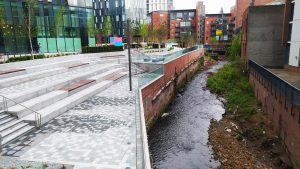The Fall and Rise of An Urban River – by Francis Hesketh CEnv MCIEEM
Not many of Manchester’s half a million residents, or the millions more who shop, party, tour and work in the city, know there is a river gently meandering through the city centre from Ancoats down to Castlefield.
For most of the last 200 years we’ve done our best to kill the River Medlock. We’ve buried it, built over it, turned our backs on it and allowed our litter and sewage to find its way into the water. Rivercide.
Only a few miles upstream in Oldham, the river Medlock is broad and tree-lined with a thriving trout fishery. Let’s ask ourselves the question – “why can’t it be the same in Manchester city centre? In fact with the city’s unique cultural and architectural heritage why can’t it be even better?!”
As part of a commission from Manchester City Council called Our Rivers Our City, we have been looking into how the city can change the River Medlock’s fortunes. Here is my take on the top 3 strategies.
#1 Design


The city centre is continuously evolving. With each new development comes an opportunity to open the river to public view and create spaces for people to interact with it. The new scheme at Deansgate Square is a good example of how to step buildings back from the river and animate the public space along one side of the river.
New development at Mayfield, near Piccadilly, takes things one step further by actually daylighting a buried river and creating a park on both sides!
For sure, the Medlock is not a great rolling river like the Thames, but it has its own urban character. Future design challenges will revolve around how to make the sheer brick flood walls that constrain the river more naturalistic and characterful. That in turn depends on improving flood storage upstream and using digital solutions to manage river water levels so that flash floods or a dry riverbed are much rarer events in the city centre.
#2 Pollution
We have still got a huge problem with water quality. Some people call this “a wicked problem”; where many interdependent factors make it seem impossible to solve. Bespoke strategies are needed for:
- Litter and flytipping
- Combined sewer overspills
- Microplastics
- Highway-related discharges
- Misconnected plumbing in homes, shops and offices leading to water from baths, kitchens and
- Unflushables
- Invasive species
- Pesticides such as dog flea treatments which get washed into surface water drains
- Silt and dust from city life
A combination of design, policy, enforcement, engineering, education and direct action is needed. The Medlock is only ten miles long, so we actually have a possibility of success. Manchester can be the first city in the world to demonstrate how to solve this multi-layered problem.
#3 Love
Clean water is one of those things that we are hard-wired to love. And we are repelled by dirty water. As we open up the River Medlock to public view and celebrate all its cultural connections, more and more people will appreciate it and campaign for it. As we recover from the coronavirus pandemic, we all understand how important it is to protect and cherish nature in our cities. Manchester’s citizens are already some of the most green-minded in the world so there is no doubt that river guardians will step forward.
But why?
Why should we make the effort to revitalise the Medlock? After all, the city has done OK for itself without too much thought for the river under its feet. During our stakeholder conversations, one of the many councillors who got involved reminded me that Manchester has 3 top priorities; jobs, equality and climate change.
Creating Jobs, Tackling Inequality and the Addressing the Climate and Ecological Emergency
Restoration of the Medlock does all the above, and more. A re-vitalised river makes the city centre an even more attractive place to live and work. Jobs will be created in a place which can be accessed by public transport, reducing the city’s carbon footprint.
Manchester’s people have suffered the inequality and indignity of pollution for 200 years, and research shows that the poorest have the worst access to green and blue spaces, with a direct effect on their wellbeing.
Finally the Medlock can become a green and well-ventilated corridor through the city centre, allowing people and wildlife to adapt to a fast-changing climate.
Imagine a city centre river where our children can go fishing!
Francis Hesketh is an ecologist specialising in green and blue infrastructure. He is passionate about restoration of habitats in the urban environment. He reflects on an 18 month commission from Manchester City Council that led to a strategy for revitalising Manchester’s rivers and urban waters. The work, funded by the EU, was carried out in conjunction with Groundwork Trust who led the community consultation, and Mersey Rivers Trust, who provided expertise on citizen science and water quality. The full strategy and delivery plan can be found here.
Blog posts on the CIEEM website are the views and opinions of the author(s) credited. They do not necessarily represent the views or position of CIEEM. The CIEEM blog is intended to be a space in which we publish thought-provoking and discussion-stimulating articles. If you’d like to write a blog sharing your own experiences or views, we’d love to hear from you at SophieLowe@cieem.net.
